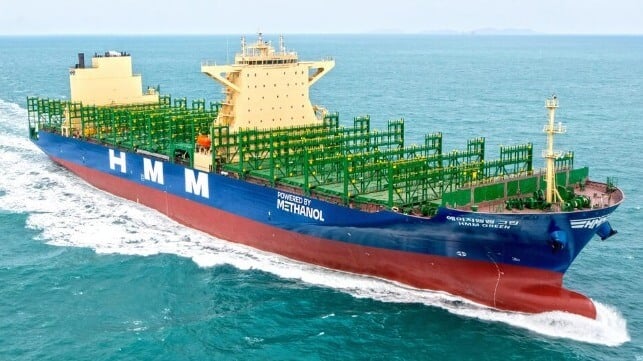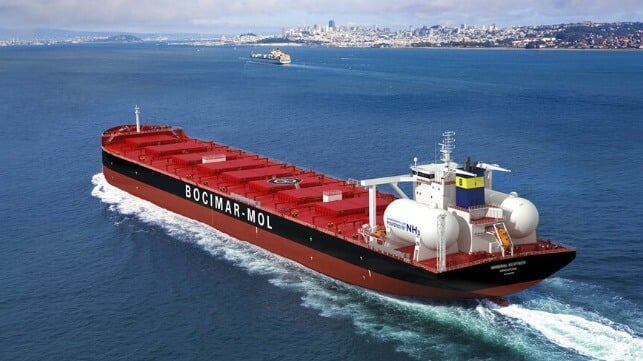HMM Joins Pioneers with its First Methanol-Fueled Containership

Published Mar 25, 2025 6:40 PM by The Maritime Executive
The ranks of container shipping companies employing methanol-fueled vessels continue to grow with HMM becoming the latest among the early adopters of the fuel. DNV calculates there are just 26 methanol-fueled containerships in service currently with orders for 200 more vessels having been placed. By comparison, there are 166 containerships fueled by LNG currently in service.
HMM ordered its first methanol vessels in February 2023 with seven to be built by HD Hyundai Samho Heavy Industries and two additional vessels at HJ Shipbuilding & Construction. The deliveries are coming this year as part of the company’s expansion and environmental plans.
The first ship, named HMM Green was delivered and is due to arrive in Busan on March 26. The vessels are 100,000 dwt with a capacity of 9,000 TEU. Their length is 274 meters (899 feet), which HMM highlights as a versatile class of ships. To maximize their ability to dock in ports around the world the company highlights a range of environmental technologies that were incorporated into the design. In addition to the methanol-fueled propulsion system, the vessel is equipped for shore power and has a ballast water treatment system.
HMM reports the new vessel will bunker with bio-methanol at the port of Shanghai. The bio-methanol is derived from waste resources. The company reports it can reduce carbon emissions by up to 65 percent, eliminate sulfur oxide (SOx) emissions, and cut nitrogen oxide (Nox) emissions by up to 80 percent compared to conventional bunker fuel.
The new vessel will be deployed on HMM’s independently operated route between Far East Asia, India, and the Mediterranean. It is part of a drive by the company which expects to reach the 1 million TEU capacity mark later this year. HMM is currently the eighth largest container carrier with a capacity of approximately 922,000 TEU.
Mitsui OSK Partners with CMB.Tech for First Ammonia-Fueled Vessels

Published Mar 24, 2025 2:32 PM by The Maritime Executive
Japan’s Mitsui O.S.K. Lines is moving forward to become one of the first of the major carriers to incorporate ammonia-fueled vessels into its fleet. MOL is joining with CMB.Tech which launched a project in 2023 to build the first ammonia-fueled large dry bulker carriers and will also expand ammonia as a fuel to its chemical tanker segment.
MOL and CMB.Tech have agreed to joint ownership of three ammonia-fitted 210,000 dwt Newcastle bulk carriers. The vessels have already been ordered at Qingdao Beihai Shipyard due for delivery in 2026 and 2027. CMB.Tech launched the project in 2023 working with WinGD to develop a 72-bore ammonia-fueled engine. After nine months of work, they announced good progress as CSSC Qingdao-Beihai Shipbuilding and CSSC Engine Company joined the project.
The vessels which were being developed for CMB’s Bocimar and were anticipated to be the first large ammonia-fueled vessels in the commercial industry. Under the terms of the new agreement, CMB.Tech and MOL will jointly own the vessels. The Japanese company will charter the three vessels each for 12 years.
The companies are expanding ammonia-fueled installations reporting a new order with China Merchants Jinling Shipyard (Yangzhou) for a total of six chemical tankers. Two of the vessels will be ammonia-fitted on delivery and the other four will be built ammonia-ready. CMB.Tech will own the vessels, which are due for delivery in 2028 and 2029, and charter the two ammonia vessels to MOL Chemical Tankers for 10 years. The Japanese company will have 7-year charters on the ammonia-ready vessels.
The MOL Group reports it intends to adopt ammonia and integrate it into the corporate environmental vision initiative. MOL’s goal is to achieve net-zero GHG emissions by 2050.
WinGD has reported that it is making solid progress in the testing of its first ammonia-fueled engines. The company has said the first engines could be ready for delivery this year.
While there is strong interest in ammonia due to its ability to eliminate carbon emissions, the shipping industry has been waiting for progress with the engines. DNV calculates that there are 31 vessels on order for delivery by 2027 that would be built for ammonia, but so far only three vessels have been retrofitted for ammonia operations. Australia’s Fortescue completed certification in Singapore for an offshore vessel while Japan’s NYK Group converted its LNG-fueled tugboat to operate with ammonia.
Alexander Saverys, CEO of CMB.Tech has been a strong proponent of ammonia as one of the tools to decarbonize shipping. He noted with these orders, CMB.Tech has increased its contract backlog by $921 million to a total of $2.94 billion. He says it demonstrates the progress on their vision of fleet rejuvenation, decarbonization, and diversification.
No comments:
Post a Comment